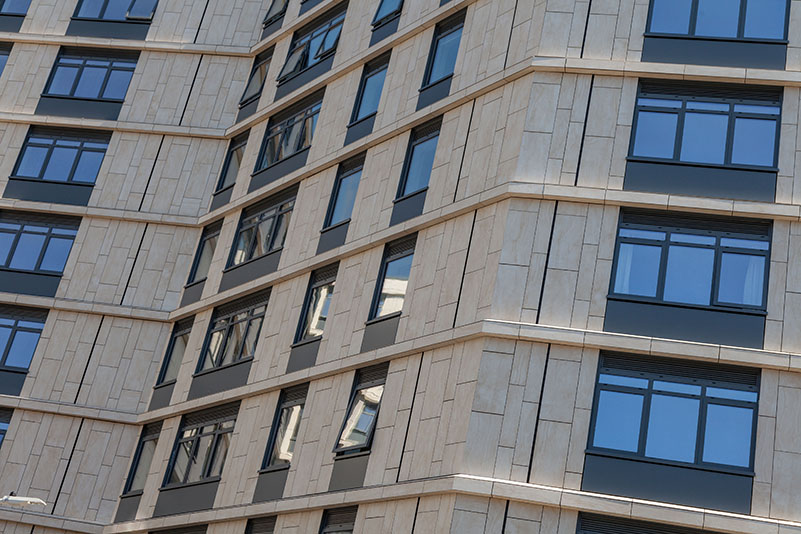
Brian G Newell MBE, founder and chief executive of British façade manufacturer, Shackerley, and the technical lead for a new international porcelain cladding standard published by BSI – ISO TS 17870-3:2023, explains what the new standard means for improved build quality.
PORCELAIN is a lightweight, exceptionally hard, and impervious material, which makes it an ideal choice for building facades.
The new ISO TS 17870-3 standard has been published by the International Standards Organisation (ISO) and BSI following international consultation with stakeholders from across the façade industry. It applies to mechanically fixed porcelain cladding systems.
Engineering out risk with installation ready panels
While façade installers are skilled specialists, they are not experts in every system they have to use. Moreover, site conditions are very different from an ISO 9001 certified factory environment, where all processes are quality assured, all equipment is checked and maintained, and contaminants cannot compromise drilled apertures for undercut anchors or connections for fixings.
To prevent the risk of poor fabrication practices and on-site fabrication issues, the ISO TS 17870-3 standard requires that all porcelain façade systems are supplied as installation-ready panels, with no drilling or fitting of undercut anchors or attached bracketry on site. Ideally, on-site cutting should also be avoided or minimised.
This stipulation will avoid the potential for reduced undercut anchor pull-out values due to ill-fitting anchors or contamination, for example, which could result in latent fracturing of the porcelain or affect wind load resistance.
Meshing and combustibility
It is common best practice for façade manufacturers to apply an anti-fragmentation mesh to the rear face of porcelain cladding panels. While the standard does not make safety meshing mandatory, it does stipulate that any meshing used should be A1 or A2-s1 d0 compliant to BS 13501-1. As porcelain is usually A1 rated for non-combustibility, this ensures that all ISO TS 17870-3-compliant porcelain façade systems are suitable for residential buildings taller than 18m.
Fixings
Where a system has been specified with apertures formed through the body of the panel to receive mechanical end fixing devices for attachment to the façade substructure, the ISO TS 17870-3 standard stipulates that the fixings should be fitted to allow for anticipated thermal expansion and contraction to help prevent stresses from developing within the façade system that could result in damage and hazards.
For edge-slotted systems, the standard allows for flexibility in the thickness of the façade panel, but recommends that the remaining front and rear edges of the slot walls should be a minimum of 5mm thick.
It also recommends that this type of fixing should be avoided for very large porcelain façade panels, as the spans between perimeter fixing points may be too large to achieve adequate restraint against negative wind loading.
Visible overlapping clip systems, where the clips overlap the porcelain façade panel around its perimeter and fix to the façade support structure are also not considered appropriate for very large panel formats. The standard advises minimum panel thickness for this type of system should be determined by the span between clips without deflection or deformation of the panel, under maximum wind loading, along with the façade system manufacturer’s advice.
Durability and impact resistance
Large format porcelain cladding panels should be proven to resist hard and soft body impact testing. The vulnerability of large format cladding panels varies depending on the location of the building and the location on the building. More significant and frequent impact is likely at lower levels where the building is more vulnerable to pedestrians, traffic and thrown objects and this should be a consideration when deciding on the thickness of the porcelain panel specified.
Due diligence
It is not possible to itemise every point set out in the new standard in a single article, which is why it is important to scrutinise ISO TS 17870-3 in full. While cladding manufacturers have a responsibility to ensure that their façade systems comply with all relevant regulations and standards, specification, procurement and installation best practice have a vital role to play in façade integrity and building safety.
The new standard has been developed to reduce the margin for error – from specification through to finished façade – and raise build quality standards. It provides a valuable opportunity for contractors to benefit from the collaboration and expertise involved in developing the document.








